FIELD VETERINARY REPORT FOR SOUTHERN CONSERVATION AREA MOBILE VETERINARY UNIT FOR THE MONTH OF MARCH 2017 Reported by Ndambiri Ephantus Introduction Due to prevailing drought the Amboseli ecosystem has had poor vegetation and browse for the wild and domesticated animals
FIELD VETERINARY REPORT FOR SOUTHERN CONSERVATION AREA MOBILE VETERINARY UNIT FOR THE MONTH OF MARCH 2017
Reported by Ndambiri Ephantus
Introduction
Due to prevailing drought the Amboseli ecosystem has had poor vegetation and browse for the wild and domesticated animals. This has resulted in animal dispersal throughout the entire ecosystem with many animals migrating into Community Conservancies which has contributed to the majority of the cases being attended outside protected areas and an increase in Human Wildlife Conflict.
The month end is marked with signs of hope as rains begin to set in. Hopefully this will regenerate the habitat providing adequate forage for both wild and domestic animals.
The Unit received an intern on 27/03/2017, Dr. M.W. Kamau, from the Kenya Director of Veterinary Services through KWS Vet Headquarters. The period of internship at the Unit will be about ten months for field work which will be followed by two months at Vet Headquarters for laboratory work. The one year internship is a mandatory requirement for any new vet graduate before permanent registration by professional body (KVB-Kenya Veterinary Board) which regulates veterinary practice in Kenya. The intern is grateful to have had such a chance in the Unit.
The following are veterinary activities attended to during the month;
CASE #1 LAME ELEPHANT
Date: 4th March 2017
Species: Elephant
Sex: Male
Age: Adult
Location: Eseregei Community Conservancy
History
Big Life Foundation Rangers reported to have seen an abnormal elephant track where it appeared the elephant was dragging one of its limbs. The elephant was tracked for three days and when it was spotted it was in company of other three huge males.
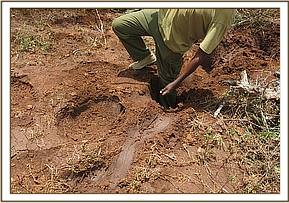
Navigation to where the elephant was last spotted was difficult as there had been a heavy downpour during the night but the vet team finally arrived and found the herd under huge acacias within heavy thickets. The vet, accompanied by an armed ranger and a Big Life Foundation Ranger, approached the elephant on foot to closely assess the injured elephant. The remainder of the teams kept a safe distance whilst the vet, mindful of the wind direction, got to within 15m of the elephant and spent about half an hour determining the extent of the elephant’s injury.
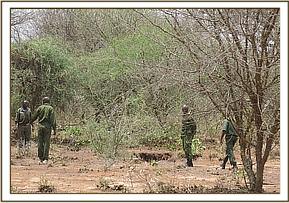

It was clear that the right hind limb had a slight swelling at the metatarsus with slight outward/lateral, deviation. In a standing position the elephant shifted weight from one limb to the other almost equally. There was no obvious wound or any discharge. The team urged the herd to ambulate so the vet could see the gait as the elephant walked.
The elephant ambulated abnormally but without any obvious sign of pain like grunting or refusing to step on the said limb.
Conclusion
The injury was not severe enough to warrant immobilization especially considering the terrain which was thicketed and wet. Immobilization posed more risk to the animal than the injury. It seemed that either the injury already healed or if recent, it wasn’t severe.
Rangers were instructed to keep monitoring the candidate and if possible a full review wound be conducted after ten days or alternatively they report if adverse signs are observed before
Prognosis
Favorable
Case Review
A review was done on the 27/3/2017 at Olgulului Community Conservancy where he was found browsing by Big Life Foundation rangers. It was clear that the defect at the metacarpal area could have been congenital as there was no scar or signs of any wound. The animal was dragging the limb when walking but moved freely when it was urged to move quickly. The animal was not darted as there was no need of immobilization
CASE #2 EUTHANASIA OF A LION
Date of death: 06/03/2017
Species: Lion
Sex: Male
Age: Adult
Location: Serengei; Amboseli
History
This lion was reported by the Lion Guardian after a night of territorial battles between resident lions. The lion left trails of profuse bleeding indicating the injured male’s location. It was identified as a collared male from Oltiasika of Chyulu Hills area and the reason for his migration has not been established. The resident pride consisted of two lionesses with at least four cubs of different ages and a territorial male. It had barely moved for the last eighteen hours.
The lion was lying under a small shrub shade and did not respond to our approach. When it did finally stand, it did so with obvious pain and difficulty. It had many skin injuries especially on the gluteal areas but also on the face, the right neck region and on the back at lumbosacral area. The injuries appeared to be of different ages; with some fresh and others depicting sepsis of over a week old.
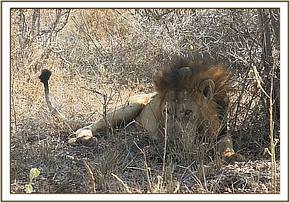
The left hind limb could hardly be used in ambulation and the head was barely held up for more than two minutes. It was panting heavily and wobbled on mobility falling several times. It could not run at all. To effect thorough examination and determine the way forward it had to be immobilized.
Immobilization and Case Management
The lion was sedated using 250mgs Ketamine and 4mgs Medetomidine. It was fully sedated in fifteen minutes assuming sternal recumbence. It was blindfolded and placed on right lateral recumbence.
There were lacerations to the skin all over the body, especially on the hind limbs, that were discharging plasma and others flank blood. The lumbosacral area injury was exposing bone while the oldest and foul smelling injury was on the right neck region laterally. It was approximated to be between one and two weeks old and had a single skin tear but was about ten centimeter deep. While all others seemed to have been due to territorial fights this particular one indicated a penetrating weapon.
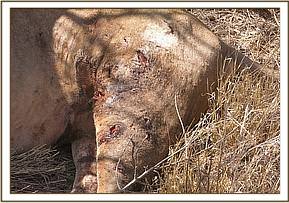

After thorough consideration of the nature of injuries, the possibilities of it gathering food on its own and ability to offer self-defense, it was concluded that it had a very poor prognosis. This necessitated euthanasia to alleviate more suffering. It was put down humanely using 40000mgs Sodium Pentobarbitone injected direct into the heart. Postmortem followed immediately.
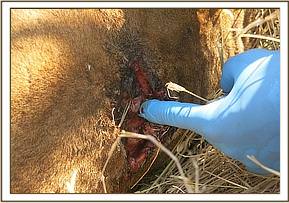
Postmortem Findings
The carcass was skinned and every injury keenly examined. There were patches of hemorrhages subcutaneously on all wounded areas with the left hind limb appearing to have the most injuries. It was evident that the right neck region injury had been inflicted by a spear which caused extensive muscle shreds before dislodging. This confirmed the antemortem ‘dropping head status’ which was due to resultant extensive supportive muscle injury. Another at the left knee area had penetrated into the joint space interfering with joint integrity hence the severe lameness observed on the left hind limb antemortem. The lumbosacral area injury had left spine bone exposed while all other wounds had not penetrated deep into muscles. These injuries were so sour that the animal was very reluctant to make any movement pre darting. Internally all organs were okay as observed after opening the carcass.
The whole of skin and head were handed over to Amboseli National Park armory for safety and onward transmission.
Conclusion
Human inflicted injuries (spear) forced this lion to migrate from the Oltiasika area where it had been dominant for the last three years. Spearing was occasioned by cattle raiding inside bomas and while grazing in the bush. Unfortunately it was fought in the new territory by another dominant male leaving it in a further compromised state.
CASE #3 POSTMORTEM OF IMPOUNDED CATTLE
Date: 7th March 2017
Species: Bovine
Age: Sub adult and Adult
Location: Ndara Plains ; Tsavo East National Park
History
A call from SW Tsavo East National Park was received on 6/3/2017 regarding deaths of impounded heads of cattle within the park. These animals had been impounded following illegal invasion and grazing within the protected area. The day of invasion was not known but they had been impounded ten days earlier within the park in the Ndara plains area and held in a constructed holding boma. Their place of origin was not clear. They were all males of between two and four years old, numbering 200, and constituted of crosses of Borana and indigenous cattle.
The Vet Unit was requested to perform postmortems to determine the cause of death. Postmortem was performed on 7/3/2017 at Ndara Plains Tsavo East National Park.
Postmortem Findings
Postmortem was done on two bulls which were dragged away from the cattle boma after dying on the afternoon of 6/3/2017. The two had been left on sternal recumbence in the morning because they were too weak to follow the herd going out for grazing. Both had good muscle cover and there was no discharge from the openings. The carcasses had begun to decompose as depicted by swelling. Both were relatively fresh to enable a meaningful postmortem to be conducted.
An important observation made while opening the carcasses was that tissues and cavities were relatively dry. There was hardly any peritoneal fluid in the stomach cavities and organ serosal surfaces were less moist. The intestines were stretched with gases and mucus specks on mucosal surface with hardly any ingesta. Incision into the rumen yielded very desiccated ruminal contents. Some of the ruminal contents were tightly attached on the ruminal villi and attempt to empty them resulted in sloughing off of the villi. The ruminal content was so dry that it could not even wet the gloves worn by the person performing the postmortem. All these findings were consistent in both carcasses.
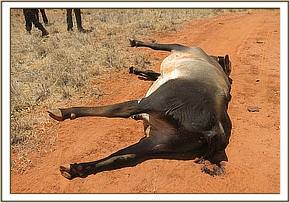

Tentative cause of death
After thorough analysis of postmortem findings the tentative cause of deaths was presumed to be severe dehydration.
Conclusion
In order to avert the ongoing deaths of impounded heads of cattle, massive water volumes are required.
More postmortems to be carried out on any dead fresh carcass to rule out or/and note other possible causes of deaths
CASE #4 POSTMORTEM OF A ZEBRA
Date of death: 20th March 2017
Date of Postmortem: 20th March 2017
Species: Zebra
Sex: Female
Age: Adult
Location: Risa; Amboseli Ecosystem
History
This zebra found dead near a Primary School and reported by the Amboseli National Park Community Warden. There was need to determine the tentative cause of death and rule out any danger of contractible disease as it was within the vicinity of children. The Vet Unit were called to carry out a postmortem.
General Observation
The zebra was lying on left lateral recumbence depicting quick decomposition and produced ping sound upon tummy percussion. Mucus membranes were congested with little bloody discharge from the left nostril. The hind limbs were fully in rigor mortis while the fore limbs were not. No skin discontinuity was noted even after turning the carcass on right recumbence. There were signs of struggle before death as shown by soil pushing during paddling. The observations made aided in ruling out possibilities of anthrax before any manipulation. It was dragged away by use of straps and vehicle to a suitable site away from the school for postmortem.
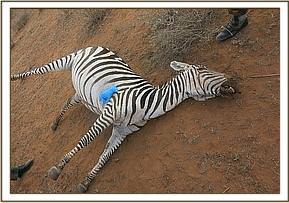

Postmortem Findings
Two locations for possible injuries were located; the head and the stomach. After extensive dissection of the carcass it was noted that the peritoneal cavity was full of intestinal contents outside the gut lumen indicating possible intestinal rupture. It was confirmed that the rupture had occurred on the descending colon about 30 centimeters from the anal opening. The ruptured area depicted heavy congestion on the edges. The peritoneal and thoracic cavities were contaminated by the intestinal contents and this extended into the thoracic muscles due to internal pressure. Lungs were pneumonic as a result.
Conclusion
The animal died of shock secondary to peritonitis due to colic which was caused by rupture of descending colon. Rupture could have occurred on a weaker colon wall due to infarction which was suggested by heavily congested edges of the rupture site.
CASE #5 TREATMENT OF AN ELEPHANT
Date: 21st March 2017
Species: Elephant
Sex: Male
Age: Sub adult
Location: Masiva; Imbirikani Amboseli Ecosystem
History
This elephant was reported by the Big Life Foundation radio room as being severely lame with a swollen left forelimb. It was within the Maasai manyattas thus posing a threat to humans. A prompt intervention was initiated.
Immobilization, examination and treatment
The elephant was monitored by Big Life rangers in a scarce thicketed area. It could barely move due to the pain on the swollen limb. The vet immobilized the elephant from a vehicle with 10mgs Etorphine and 1500I.U. Hyalase The elephant was turned using straps pulled by a vehicle to the right lateral recumbence to enable wound visibility.
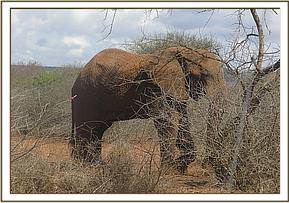

The left forelimb was heavily swollen from the scapular downwards with pus discharging from a penetrating spear wound at the elbow laterally. The wound was about 15cm deep and probed for any foreign object with pincers but nothing was recovered.


The wound cleaned with copious amount of Hydrogen Peroxide and Tincture of Iodine to remove all the pus. It was infiltrated with three Cloxacillin cream tubes followed with a generous coating of green clay. In addition 50mgs Dexamethasone was injected intravenously to act as anti-inflammatory and 30000mgs Tetracycline was injected into the muscles to take care of secondary bacterial infection. 100ml Catosal was injected in a different muscle site as metabolic stimulant.
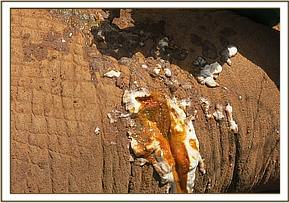

Reversal and Prognosis
Before the animal was revived a vehicle with a strap hooked on the left tusk was put on standby to assist the week candidate to get up if need be. The anesthetic was then reversed by use of 100mgs Naltrexone into the ear vein. The candidate was up in two minutes by itself despite the anticipated assistance. The strap fell off itself from the tusk.
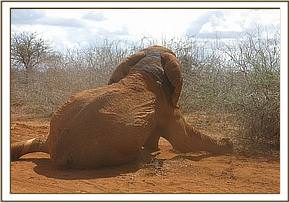

Guarded but will be revised following review after seven to ten days
CASE #6 EUTHANASIA OF A WILDEBEEST CALF
Date of death: 25th March 2017
Species: Wildebeest
Sex: Female
Age: Calf
Location: Western Enclosure; Amboseli National Park
History
The report of an injured wildebeest calf came from Deputy Park Warden Amboseli National Park after it was spotted during an animal census carried out on the same day. It was reported to be lame on the right fore limb. An intervention was carried out the same day.
General Observation
It was lying down in an open savannah area but got up upon approach and depicted swinging leg lameness. It was accompanied by its dam and another female. The calf appeared to be about two weeks old. Keen observation using binoculars depicted a complete fracture of the metacarpus with bone edge protruding outside the skin. This could have possibly been due to plunging/tripping into a hole whilst running. The injury was deemed too severe for treatment and a decision was reached to put it down to alleviate more suffering and before osteomyelitis sets in.
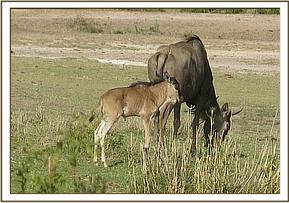

Postmortem Findings
There was a complete open metacarpus fracture of the right fore limb.
ACKNOWLEDGEMENT
We overwhelmingly appreciate unfaltering equipment and financial support from David Sheldrick Wildlife Trust and friends as sponsor of the Southern Conservation Area Mobile Veterinary Unit. It is from the Trust partnership with KWS and other friends of Conservation that the above work has been achieved. Thank you all.





















